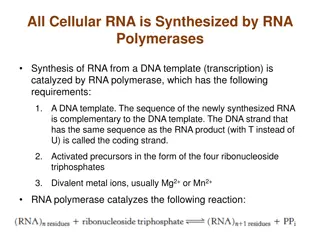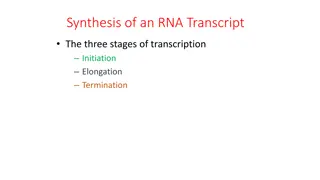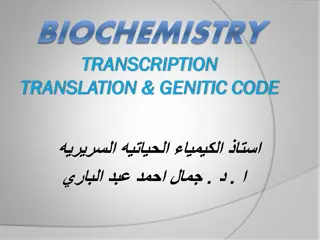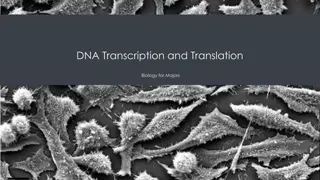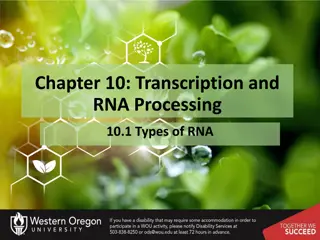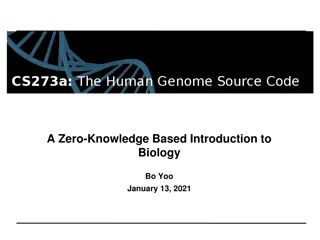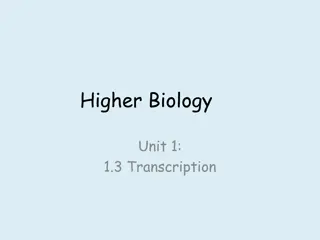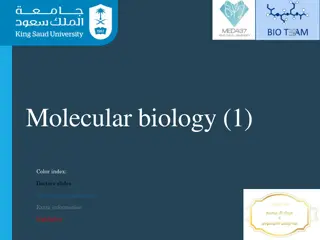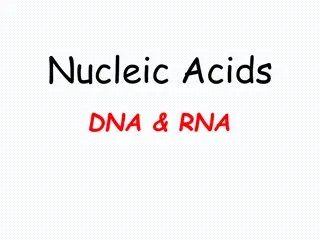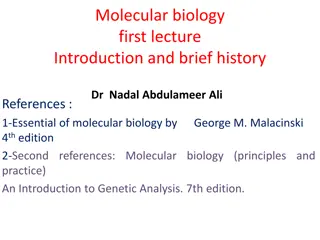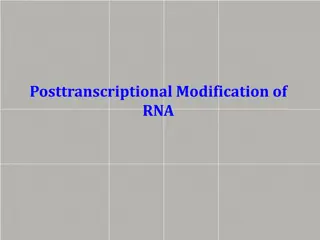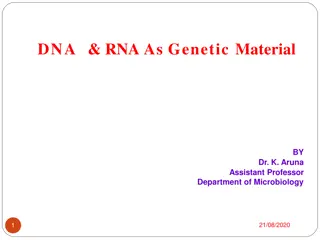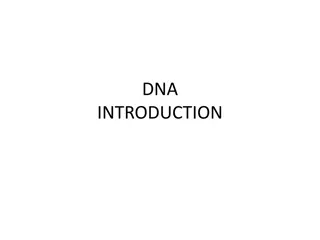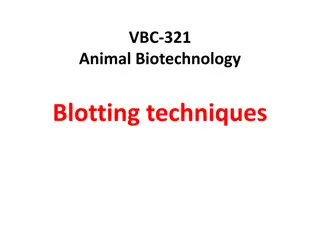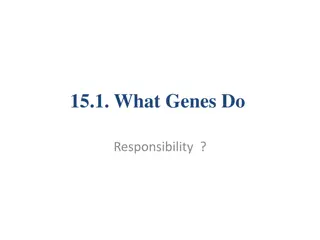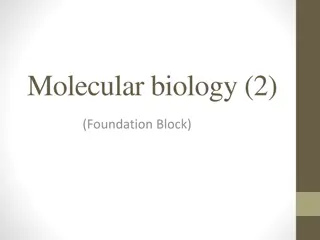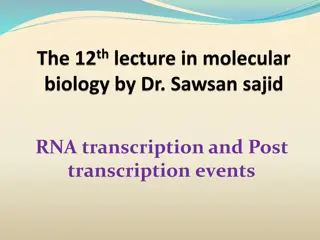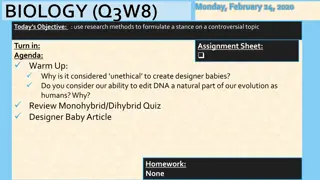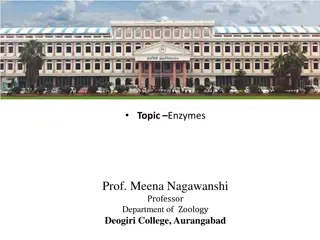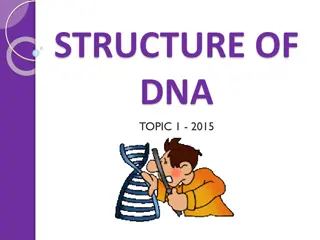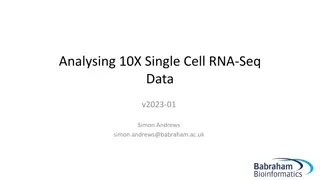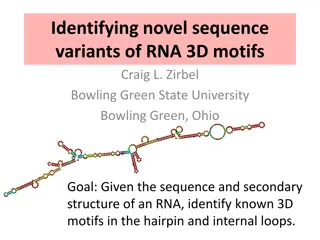Understanding Computational Biology: Proteins, DNA, RNA, Genetics, and Evolution
Computational Biology combines computational methods with molecular biology to solve biological problems. Explore topics like proteins, DNA, RNA, and genetics, learning about amino acids, nucleotides, and the genetic code. Understand the evolutionary processes of mutation and natural selection.
Download Presentation

Please find below an Image/Link to download the presentation.
The content on the website is provided AS IS for your information and personal use only. It may not be sold, licensed, or shared on other websites without obtaining consent from the author. Download presentation by click this link. If you encounter any issues during the download, it is possible that the publisher has removed the file from their server.
E N D
Presentation Transcript
Prepared By: Syed Khaleelulla Hussaini
Outline Proteins DNA RNA Genetics and evolution The Sequence Matching Problem RNA Sequence Matching Complexity of the Algorithms
DEFINITION Computational Biology encompasses all computational methods and theories applicable to molecular biology and areas of computer based techniques for solving biological problems.
Protiens They are building blocks of living organism It is a large molecule that is composed of sequences of amino acids There are 20 amino acids which are divided into classes hydrophobic(h-phob) hydrophillic(h-phil) polar(pos,neg)
Amino acid codes Name, 3-letter & single-letter codes Aspartic Acid Phenylanine Alanine Histidine Lysine Methionine Proline Arginine Threonine Tryptophan Asp Phe Ala A Cystine His H Lys K Met M Pro P Arg R Thr T Trp W D F Glutamic Acid Glycine Glu Gly Cys Ile Leu Asn Gln E G C I L N Q S V Y Ser Isoleucine Leucine Asparagine Glutamine Serine Valine Tyrosine Val Tyr
DNA(Deoxyribonucleic acid) Blueprint of living organisms DNA is composed of two strands hold by a weak hydrogen bond Each strand is a sequence of nucleotides DNA has four bases which are classified as two chemical types BASE SYMBOL TYPE Adenine A Purine Thymine T Purine Sytosine C Pyrimidine Guanine G Pyrimidine
RNA RNA is chemically very similar to DNA There are two important differences Four bases present in RNA are: Adenine(A) Guanine(G) Cystosine(C) Uracil(U) RNA nucleotides contain a different sugar molecule(ribose)
Genetics and Evolution Mutation The changing of the structure of a gene, resulting in a variant form that may be transmitted to subsequent generations, caused by the alteration of single base units in DNA. Natural selection The process whereby organisms better adapted to their environment tend to survive and produce more offspring. Genetic Drift Variation in the relative frequency of different genotypes in a small population.
Sequence matching problem Proteins are longer and DNA strands are even longer We match them by breaking them in to shorter subsequences Breaking and matching is done by notion of alignment.
Sequence matching example Consider two amino acid sequences: ACCTGAGAG ACGTGGCAG sequence alignment A C C T G A G A C A C G T G G C A C
Finite state machines in blast It is used to find out which of the sequences in a database are related to the new given sequence using BLAST The BLAST system is a three step process: 1. Examine the query string and select set of substrings of length w(between 4 and 20) which are good for producing matches 2. Build a DFSM that uses set of substrings and find the sequences with the highest local matches in the database 3. Examine the matches found in step2 and try to build a longer matching sequences
Regular expressions specify protein motif Aligning collection of related proteins we can define a motif Example: E S G H D T Y Y NKN R M D T T T T T S W QS R G S D T T T P D MT A G P T T W R NT Once an motif is defined we can search for the occurrences of it in other protein sequence by using regular expressions
HMM for sequence matching HMM s are used when sequences become fairly diverse We can capture the variations among the members of the family and the probabilities associated with them So by using HMM s we can find the best alignment between two sequences and from which family does a given new sequence belongs to
HMM profile is given by M = (K,O, ,A,B) K is a set of n states, one for each position in the sequence O is the output alphabet contains the initial state probabilities A contains the transition probabilities B contains the output probabilities
Example of HMM describing protein sequence family
RNA sequence matching and secondary structure prediction using the tools of context-free languages In RNA a change to a single nucleotide in a stem region could completely alter the molecules shape and its function So an change in the stem must be matched by a corresponding change in the paired nucleotide Context free languages are used describe these nested dependencies and secondary structure
Complexity of algorithms used in computational biology Approaches to many of the problems described here are computational like breaking up of large protein and DNA molecules into substrings NP-hard Conversion to decision problem SHOERTEST-SUPERSTRING(<S,K> ): S is a set of strings and there exists some superstring T such that every element of S is a substring of T and T has length less than or equal to K) NP-complete
Reference http://en.wikipedia.org/wiki/Computational_biology http://www.google.com http://www.cs.utexas.edu/~ear/cs341/automatabook/


